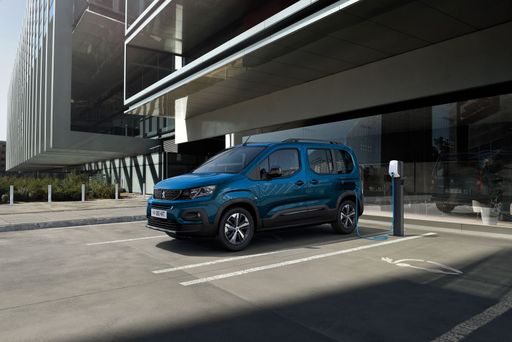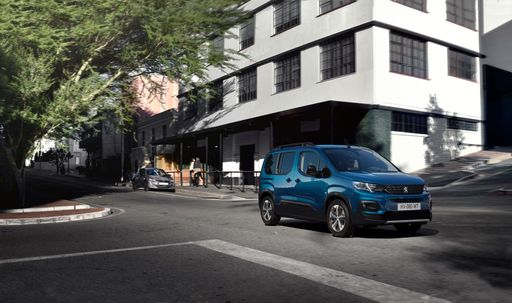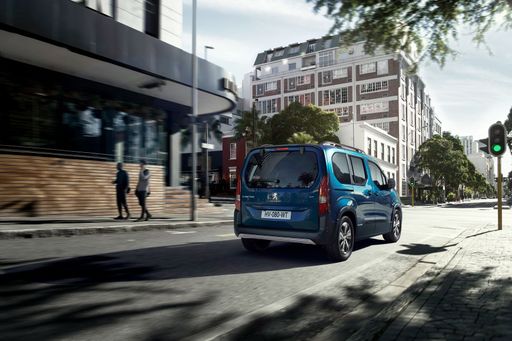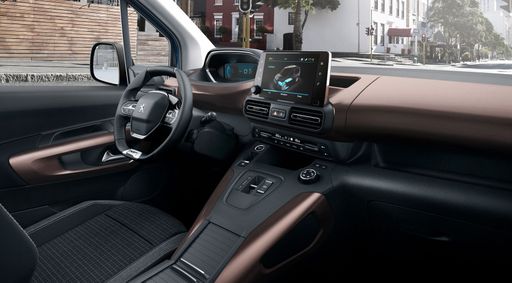Peugeot Partner VS Peugeot Rifter – Specs, Efficiency & Price Comparison
Which model is the better choice – the Peugeot Partner or the Peugeot Rifter? We compare performance (136 HP vs 136 HP), boot capacity (1800 L vs 1050 L), efficiency (17.40 kWh5.20 L vs 19.10 kWh5.60 L), and of course, the price (20500 £ vs 23800 £).
Find out now which car fits your needs better!
The Peugeot Partner (Cargo Van) is powered by a Electric, Diesel or Petrol engine and comes with a Automatic or Manuel transmission. In comparison, the Peugeot Rifter (High Roof Estate) features a Electric or Diesel engine and a Automatic or Manuel gearbox.
When it comes to boot capacity, the Peugeot Partner offers 1800 L, while the Peugeot Rifter provides 1050 L – depending on what matters most to you. If you’re looking for more power, you’ll need to decide whether the 136 HP of the Peugeot Partner or the 136 HP of the Peugeot Rifter suits your needs better.
There are also differences in efficiency: 17.40 kWh5.20 L vs 19.10 kWh5.60 L. In terms of price, the Peugeot Partner starts at 20500 £, while the Peugeot Rifter is available from 23800 £.
Compare all the key specs now and find out which model fits your lifestyle best!
In the battle of practicality and versatility, the Peugeot Socio stands out with its contemporary design and efficient use of space, making it an ideal choice for urban dwellers. In contrast, the Peugeot Rifter impresses with its robust exterior and family-friendly features, offering ample cargo capacity and clever storage solutions for larger adventures. Ultimately, the choice between the two boils down to personal needs, whether prioritizing stylish daily commuting or accommodating a bustling family lifestyle.
Peugeot Partner
The Peugeot Partner is a versatile and practical vehicle, ideal for both urban and rural settings. Its spacious interior and adaptable seating make it a popular choice for families and businesses alike. With a focus on reliability and efficiency, the Partner is well-suited to meet the demands of everyday transport.
detailsPeugeot Rifter
Der Peugeot Rifter beeindruckt mit seinem robusten Design und seiner hohen Vielseitigkeit, die ihn ideal für Familien und Outdoor-Abenteuer macht. Der Innenraum ist geräumig gestaltet und bietet zahlreiche innovative Technologien, die den Komfort und die Sicherheit der Insassen erhöhen. Zudem überzeugt der Rifter mit seiner hervorragenden Fahrdynamik, die sowohl in der Stadt als auch auf längeren Strecken für ein angenehmes Fahrerlebnis sorgt.
details @ media.stellantis.com
@ media.stellantis.com
 @ media.stellantis.com
@ media.stellantis.com
 @ media.stellantis.com
@ media.stellantis.com
 @ media.stellantis.com
@ media.stellantis.com
Peugeot Socio vs Peugeot Rifter: A Comprehensive Comparison
As the automotive market continues to evolve, Peugeot has made significant strides with its two versatile models: the Peugeot Socio and the Peugeot Rifter. These cars cater to different customer needs while sharing some of the same technological DNA. In this article, we will delve deep into the technical aspects and innovations of both vehicles, showcasing their strengths and capabilities.
Body Type: Versatility in Design
The Peugeot Socio is designed as a cargo van, focusing primarily on practicality and utility. Its spacious interior offers a trunk capacity of 1800 liters, making it perfect for transporting goods or tools. On the other hand, the Peugeot Rifter is a high roof wagon, emphasizing user comfort and passenger space with seating options for up to seven people and a trunk capacity ranging from 322 liters to 1050 liters depending on the configuration.
Engine and Performance: Power Options
When it comes to engine types, both the Socio and Rifter offer a range of options. The Socio showcases three engine types: electric, diesel, and petrol, delivering power outputs between 102 to 136 hp. Its electric variant features a robust range of 354 km, making it an ideal choice for eco-conscious consumers. With a 0-100 km/h acceleration time of 11.2 seconds in its most powerful diesel configuration, the Socio is no slouch in performance.
Conversely, the Rifter also offers electric, petrol, and diesel options but with a slightly lower maximum power output ranging from 102 to 136 hp. It has a fast acceleration time of 10.8 seconds in its more powerful configurations, and an electric range of up to 340 km. This model strikes a balance between efficiency and power, making it a great option for family outings and daily commutes alike.
Transmission and Driving Experience
Both vehicles come equipped with front-wheel drive and various transmission options, including automatic and manual gearboxes. The Socio features a reduction gearbox alongside its manual and automatic gearboxes, optimizing it for heavy loads and varying terrains. Its power torque ranges from 205 to 300 Nm, providing added flexibility and control during operation.
The Rifter also shares similar transmission details and performance parameters but focuses more on comfort during city driving, thanks to its smooth automatic transmission options. Its torque ranges from 205 to 300 Nm as well, allowing for an engaging driving experience whether you’re navigating through city traffic or heading out of town.
Fuel Efficiency and Environmental Impact
In an age where fuel efficiency is paramount, both Peugeot models hold their ground. The Socio's fuel consumption is impressive, particularly with its diesel engines averaging between 5.2 to 6.3 liters per 100 km. The electric version consumes 17.4 kWh per 100 km, offering a sustainable choice for long-term use.
The Rifter, while slightly less efficient than the Socio, still provides commendable petrol and diesel options averaging between 5.4 to 6.9 liters per 100 km. For electric variants, it registers consumption at approximately 19.1 kWh per 100 km. Both models are available in CO2 efficiency class A, showcasing their environmentally friendly credentials.
Dimensions and Usability
Size plays a critical role in usability. The Peugeot Socio has a length of 4751 mm and a height of 1812 mm, providing ample space without compromising on maneuverability. The Rifter, comparatively, offers two lengths: 4405 mm and 4755 mm. With a height of up to 1837 mm, it has a high-roof design that maximizes interior space for passengers and cargo alike.
Conclusion: Choosing the Right Peugeot for You
Ultimately, the choice between the Peugeot Socio and Peugeot Rifter boils down to your individual needs. The Socio is an excellent choice for professionals seeking a practical, spacious cargo van that excels in utility and energy efficiency. In contrast, the Rifter appeals to families and individuals looking for a more comfortable ride with ample passenger capacity and modern amenities.
With their unique features and capabilities, both models underline Peugeot's commitment to quality, performance, and innovation in the automotive industry. Whether you choose the Socio or the Rifter, you can be assured of a reliable driving experience that fits your lifestyle.

|
|
|
|
|
Costs and Consumption |
|
|---|---|
|
Price
20500 - 33800 £
|
Price
23800 - 36300 £
|
|
Consumption L/100km
5.2 - 6.3 L
|
Consumption L/100km
5.6 - 6 L
|
|
Consumption kWh/100km
17.40 kWh
|
Consumption kWh/100km
19.1 - 19.2 kWh
|
|
Electric Range
354 km
|
Electric Range
329 - 340 km
|
|
Battery Capacity
-
|
Battery Capacity
-
|
|
co2
0 - 143 g/km
|
co2
0 - 158 g/km
|
|
Fuel tank capacity
53 - 61 L
|
Fuel tank capacity
50 L
|
Dimensions and Body |
|
|---|---|
|
Body Type
Cargo Van
|
Body Type
High Roof Estate
|
|
Seats
2 - 5
|
Seats
5 - 7
|
|
Doors
4 - 5
|
Doors
4 - 5
|
|
Curb weight
1329 - 1813 kg
|
Curb weight
1561 - 1941 kg
|
|
Trunk capacity
1800 L
|
Trunk capacity
322 - 1050 L
|
|
Length
4401 - 4751 mm
|
Length
4405 - 4755 mm
|
|
Width
1848 mm
|
Width
1848 mm
|
|
Height
1796 - 1812 mm
|
Height
1818 - 1837 mm
|
|
Payload
611 - 991 kg
|
Payload
489 - 814 kg
|
Engine and Performance |
|
|---|---|
|
Engine Type
Electric, Diesel, Petrol
|
Engine Type
Electric, Diesel
|
|
Transmission
Automatic, Manuel
|
Transmission
Automatic, Manuel
|
|
Transmission Detail
Schaltgetriebe, Automatikgetriebe
|
Transmission Detail
Schaltgetriebe, Automatikgetriebe
|
|
Drive Type
Front-Wheel Drive
|
Drive Type
Front-Wheel Drive
|
|
Power HP
102 - 136 HP
|
Power HP
102 - 136 HP
|
|
Acceleration 0-100km/h
11.2 - 14.8 s
|
Acceleration 0-100km/h
10.8 - 13.6 s
|
|
Max Speed
135 - 184 km/h
|
Max Speed
132 - 184 km/h
|
|
Torque
205 - 300 Nm
|
Torque
250 - 300 Nm
|
|
Number of Cylinders
3 - 4
|
Number of Cylinders
4
|
|
Power kW
75 - 100 kW
|
Power kW
75 - 100 kW
|
|
Engine capacity
1199 - 1499 cm3
|
Engine capacity
1499 cm3
|
General |
|
|---|---|
|
Model Year
2024
|
Model Year
2024
|
|
CO2 Efficiency Class
A, E
|
CO2 Efficiency Class
A, E, F
|
|
Brand
Peugeot
|
Brand
Peugeot
|
Peugeot Partner
Exploring the Peugeot Partner: A Blend of Versatility and Innovation
The Peugeot Partner has long been a staple in the world of light commercial vehicles, offering practicality and reliability. However, with the latest iterations, Peugeot has taken a bold step by integrating advanced technology and modern design to create a vehicle that's not just functional, but also efficient and environmentally friendly. Let's dive into the technical details and innovations that make the latest Peugeot Partner a standout choice in its class.
Efficient Powertrains: Diesel, Petrol, and Electric Choices
The 2024 Peugeot Partner provides a wide range of powertrains to suit different needs and preferences. Whether you're looking for the tried-and-tested efficiency of a diesel engine, the simplicity of petrol, or the future-ready appeal of electric, the Partner offers them all. With power outputs ranging from 102 to 136 PS and options for automatic and manual transmissions, it caters to those who desire flexibility in vehicle performance.
Embracing Electric: The E-Partner Revolution
One of the most notable features of the latest Peugeot Partner is the introduction of the e-Partner, an all-electric variant. This model comes equipped with a 50 kWh battery, providing a significant range of up to 354 km on a single charge, making it ideal for urban deliveries or longer commutes with no emissions. Its front-wheel-drive layout and electric motor deliver 136 PS, ensuring a lively yet smooth driving experience.
Room for More: Versatility and Cargo Space
Peugeot understands the importance of adaptability in commercial vehicles. The Partner offers up to 1,800 litres of cargo space, or the capacity to carry payloads ranging from 611 to 991 kg. Additionally, the choice of 4 to 5 doors and seating configurations from 2 to 5 seats ensures that the Partner can be customised to meet the specific needs of various business requirements.
Compact Yet Capable: Dimensions and Design
The Peugeot Partner showcases a clever balance of compact exterior dimensions and a spacious interior. With lengths between 4,401 mm and 4,751 mm, and a width of 1,848 mm, it delivers easy manoeuvrability in urban environments without compromising on cargo capacity. The height ranges from 1,796 mm to 1,812 mm, ensuring stability and on-road presence.
An Eye on Sustainability: CO2 Emissions and Efficiency
Peugeot's commitment to sustainability is evident in the Partner's diverse powertrain options and their associated CO2 emissions, which range from zero for the electric variant to a maximum of 143 g/km for certain internal combustion engine models. This variety allows businesses to choose based on their environmental goals as well as operational needs.
A Multi-Talented Performer: Performance and Practicality
With acceleration figures from 0-100 km/h in just 11.2 seconds for some models and a top speed of up to 184 km/h, the Partner is not just about practicality; it's also about performance. The available torque between 205 and 300 Nm contributes to confident driving dynamics whether navigating urban settings or cruising on the motorway.
Conclusion: The Partner of the Future
The Peugeot Partner continues to be a frontrunner in the small van segment, thanks to its innovative approach to design, fuel efficiency, and technological integration. By providing a range of powertrain options and configurations, the Partner meets the diverse needs of today's businesses while keeping an eye firmly on the future. Whether opting for the environmentally friendly e-Partner or the robust diesel variant, Peugeot has crafted a vehicle that truly earns the name "Partner".
Peugeot Rifter
Der perfekte Begleiter für jede Fahrt: Der Peugeot Rifter
Der Peugeot Rifter hat sich als vielseitiger Hochdach-Kombi auf dem Markt etabliert. Mit seinem anpassungsfähigen Innenraum und einer Vielzahl von Antriebsvarianten bietet der Rifter für viele Anforderungen die passende Lösung. Ob als Familienauto oder für den urbanen Lieferverkehr – der Rifter passt sich flexibel den jeweiligen Bedürfnissen an.
Innenraum und Komfort
Der Innenraum des Peugeot Rifter ist so konzipiert, dass er sowohl Komfort als auch Funktionalität bietet. Mit bis zu sieben Sitzen eignet sich das Fahrzeug perfekt für größere Familien oder Gruppen. Der variable Kofferraum bietet ein Fassungsvermögen von bis zu 1050 Litern, sodass auch größere Lasten problemlos transportiert werden können.
Technische Details und Motorvarianten
Der Peugeot Rifter ist mit einer Vielzahl von Antriebsarten verfügbar. Neben den sparsamen Benzin- und Dieselmotoren bietet Peugeot auch innovative Elektrovarianten an. Die Leistungsbandbreite reicht von 102 PS bis 136 PS, je nach gewähltem Modell und Motoroption.
Die Elektromodelle, unter dem Namen e-Rifter bekannt, bieten eine beeindruckende Reichweite von bis zu 340 km und sind somit bestens geeignet für den täglichen Pendelverkehr in städtischen Gebieten. Dank der verschiedenen Getriebetypen, von manuellen Getrieben bis hin zu achtstufigen Automatikgetrieben, findet jeder Fahrer das für ihn passende Fahrgefühl.
Innovationen und Sicherheit
Peugeot hat den Rifter mit einer Vielzahl von Sicherheits- und Assistenzsystemen ausgestattet. Dazu zählen unter anderem adaptive Geschwindigkeitsregelung, Spurhalteassistent und ein autonomer Notbremsassistent. Mit diesen Systemen sorgt der Rifter für ein hohes Maß an Sicherheit und Komfort auf der Straße.
Der umweltfreundlichere Weg
Besonders erwähnenswert ist die Effizienz seiner Elektrovarianten. Mit einem durchschnittlichen Verbrauch von 19,1 bis 19,2 kWh/100 km leistet der e-Rifter einen Beitrag zur umweltfreundlicheren Mobilität. Auch die CO2-Effizienzklasse der Diesel- und Benzinvarianten ist mit Werten von A bis E bemerkenswert.
Fazit: Ein Auto für alle Fälle
Der Peugeot Rifter ist mehr als nur ein Fahrzeug – er ist ein verlässlicher Partner für das tägliche Leben. Mit seinem geräumigen Innenraum, den flexiblen Antriebsoptionen und den fortschrittlichen Sicherheitsmerkmalen zeigt der Rifter, dass Stil und Funktionalität harmonisch vereint werden können. Egal ob auf der Autobahn oder in der Stadt: Der Rifter ist bereit, jede Herausforderung zu meistern.
The prices and data displayed are estimates based on German list prices and may vary by country. This information is not legally binding.
